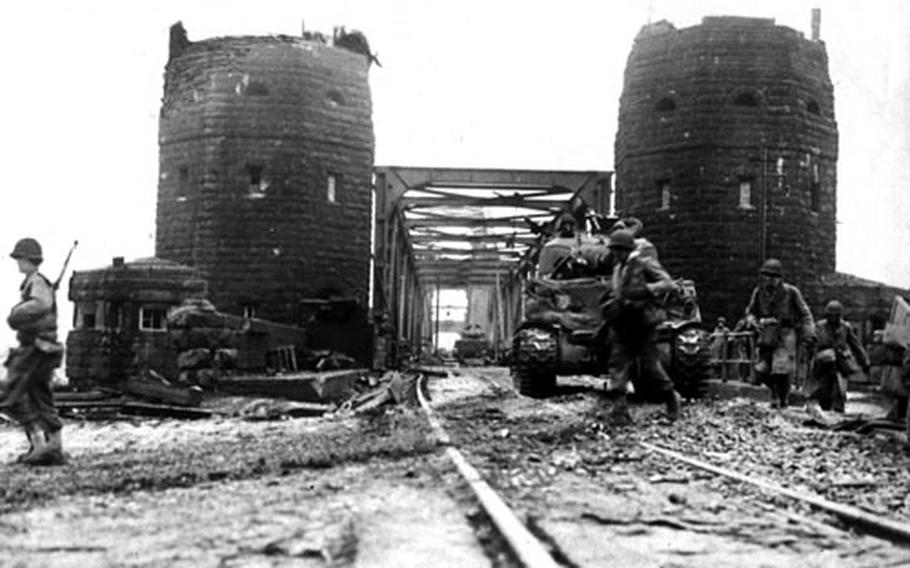
U.S. soldiers stand guard as engineers from the 9th Armored Division strengthen the bridge at Remagen, Germany, in March 1945. The bridge was originally for railroad traffic, but planks were placed across the tracks so wheeled vehicles could cross. The Germans, who tried to destroy the bridge with explosives and air attacks, finally succeeded, killing 28 engineers who had been trying to strengthen the bridge. (Stars and Stripes)
War has a way of ripping the covers off sleepy little villages.
Small towns like Sainte-Mère-Église, Bastogne and Auschwitz, for example, gained notoriety during and after World War II for reasons unique unto themselves. Sometimes the reasons became a source of pride, and other times a source of shame or anguish.
One place unwittingly dragged into the spotlight was Remagen, a quiet riverside village in western Germany that once had a railroad bridge.
Before World War II, “nobody spoke of Remagen,” said Hans Peter Kürten, who founded a peace museum within the bridge’s tower walls.
That obscurity changed the afternoon of March 7, 1945, when a company of U.S. 9th Armored Division soldiers emerged from the woods west of town.
Before and below them stood the Ludendorff Bridge and the Rhine River. It was a sight that must have had them rubbing their eyes because the German army, under Adolf Hitler’s orders, was destroying bridges spanning the Rhine to slow the Allies’ advance.
To make matters even more favorable for the Allies, the Germans were lightly defending the bridge, which only the night before had been readied for vehicle traffic. Within three hours, the bridge was in U.S. hands, thousands of troops were hustling across under German artillery and small-arms fire, and many, many more were making a beeline for Remagen.
“It’s called the ‘Miracle of Remagen,’ ” Kürten said. “The Germans didn’t have enough soldiers and munitions to defend or blow up the bridge. The war in Europe ended sooner because of it.”
Some soldiers described the bridge as ugly, though it allowed them and many others to “Cross the Rhine with dry feet,” as the rallying cry went. To Gen. Dwight D. Eisenhower, the bridge was “worth its weight in gold.”
Weakened by the German army’s persistent efforts to destroy it, the span collapsed 10 days later, killing at least 28 U.S. soldiers. (Kürten says the number is really 30.)
Today, all that remains of the bridge are the dark, stone towers opposite each other on the Rhine. On the Remagen side of the river is where Kürten and others in town joined forces to create their museum to war and peace.
“It’s nice they did something with it [the towers],” Georg Masek of Switzerland said as he toured the museum. “When I think of what happened here 60 years ago, I shiver.”
When U.S. Army veterans of the operation think of Remagen in March, they get chills, too. In fact, veterans have asked Kürten and other village leaders to hold a 60th-anniversary observance later because of the weather, and they have complied.
The museum, which is open from March through November, is a breeze to tour. The roundness of the towers and the mix of displays — German and American, war and peace — make for a short and enjoyable visit. That’s especially so on a warm spring or summer day when the cafes are open and the walk along the boardwalk is populated with visitors and residents alike.
On the QT ...
DIRECTIONS: The Friedensmuseum Brücke von Remagen is along the Rhine River on the south side of town. Get off Autobahn 61 (north of Koblenz) at the Remagen exit and take Highway 266 east toward town. At Highway 9, turn left and go north. The road enters Remagen from the south, with the river on the right. Look for the signs to the museum, though parking in town is OK because of the walkway running along the river.
TIMES: The museum typically opens on or about March 7 and closes at the end of November. Hours are 10 a.m. to 6 p.m., though in March, April and November, the closing time is 5 p.m.
COSTS: Admission to the museum is 3.50 euros for adults; children, students and disabled people pay 1 euro; individuals pay 2 euros apiece in groups of 10 or more; the family rate is 6 euros.
FOOD: There are a few cafes and restaurants on the town square. Among them is the Weinhaus Grüner Kranz, a yellow building with green shutters.
INFORMATION: See the English version of the museum's Web site. Telephone: (+49) (0) 2642- 21863 or (+49) 2642-20159.
— Kevin Dougherty